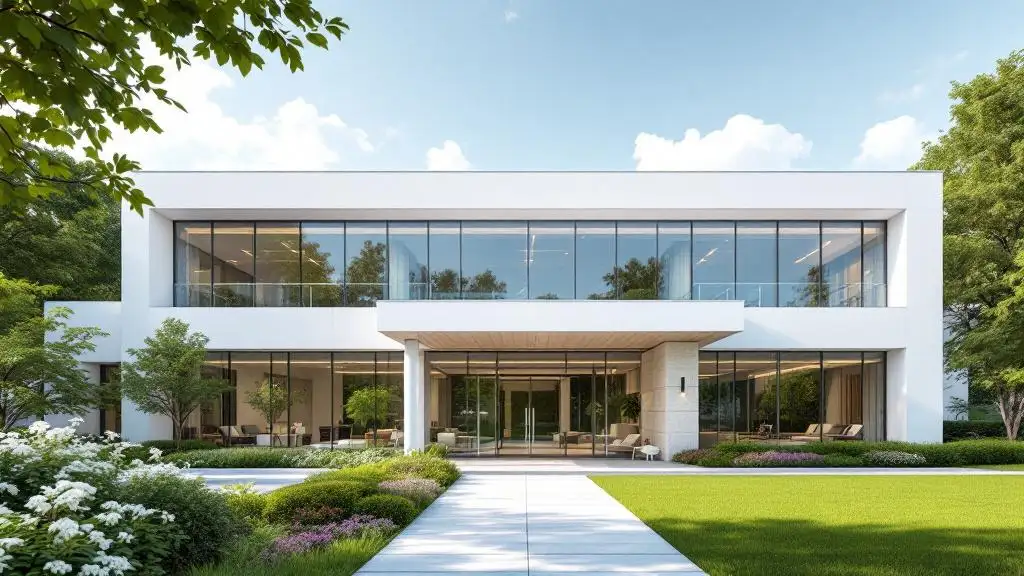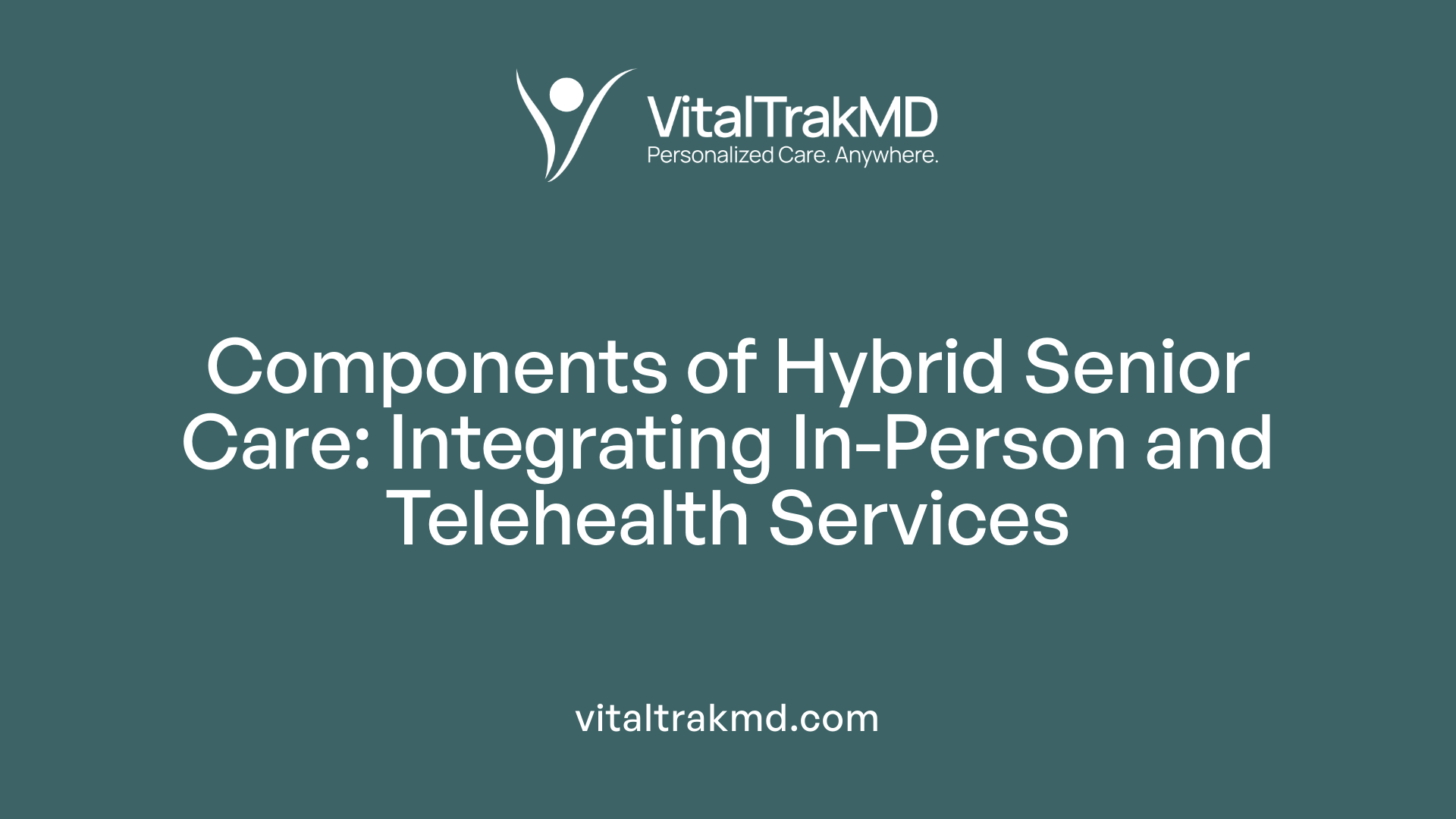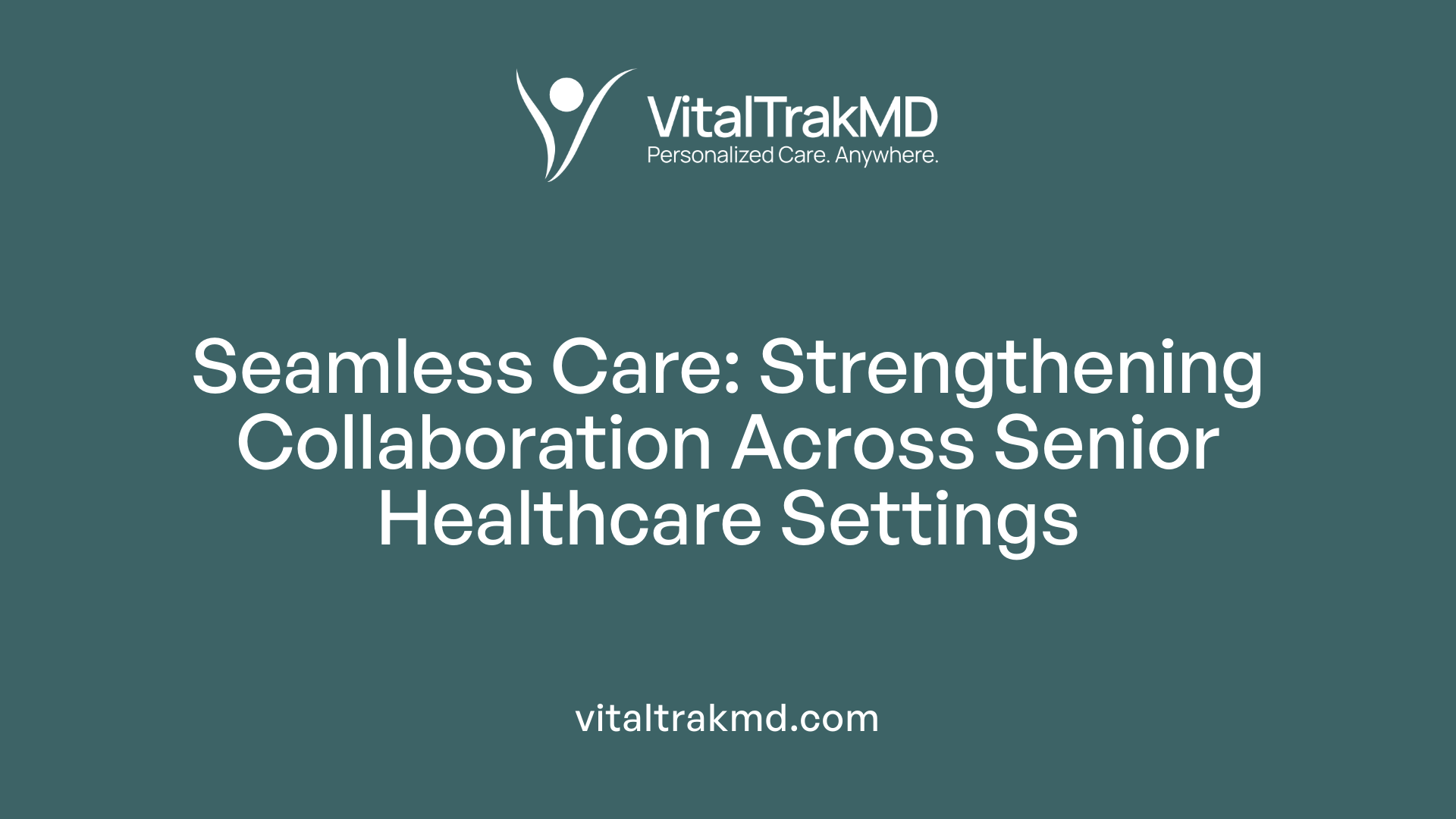Understanding the Care Continuum Within Hybrid Healthcare for Seniors

Exploring the Foundations and Future of Senior Healthcare Systems
As populations age globally, healthcare systems face the urgent need to evolve towards more integrated, patient-centered models. Hybrid healthcare systems, which blend traditional in-person care with cutting-edge telehealth technologies, alongside comprehensive care continuums, form the backbone of innovative strategies to improve health outcomes among older adults. This article examines how these models operate, their benefits, and the systemic changes needed to support seamless, effective care for seniors across diverse settings.
Defining Hybrid Healthcare Systems in Senior Care

What is a hybrid healthcare system?
A hybrid healthcare system integrates traditional in-person medical care with innovative telehealth services, creating a flexible and patient-centered approach suitable for senior care. This model leverages digital technologies to extend the reach of healthcare providers, enhancing access and convenience for older adults. It combines face-to-face visits at clinics, hospitals, or care facilities with remote consultations, remote monitoring, and digital communication channels.
Centralized scheduling systems are vital to managing this hybrid model effectively. These systems coordinate in-person appointments with virtual visits, allowing seamless transition and continuity of care. They support both modalities within a unified platform, making it easier for seniors to receive care regardless of location or mobility limitations.
Innovative platforms like Relatient exemplify the capabilities of hybrid healthcare. These tools facilitate virtual waiting rooms, digital check-ins, contactless pre-registration, and secure patient-provider communication. Such features promote safety—particularly critical during the COVID-19 pandemic—and enhance the overall patient experience.
The primary goal of a hybrid healthcare system is to deliver comprehensive, accessible, and efficient care tailored to the needs of the elderly. By integrating digital solutions with traditional services, it improves safety, reduces unnecessary hospital visits, and ensures that seniors receive timely interventions.
Components of hybrid care
Hybridity in senior care involves multiple interconnected components:
| Component | Description | Benefit |
|---|---|---|
| In-person services | Traditional consultations, examinations, and procedures | Physical assessment and hands-on care |
| Telehealth modalities | Video calls, remote consultations, and health monitoring | Convenience and reduced travel |
| Remote monitoring | Wearable devices, sensors, and digital health tools | Continuous health tracking |
| Digital communication | Secure messaging, email, and patient portals | Ongoing engagement and information sharing |
| Centralized scheduling | Unified appointment management system | Efficient care coordination |
Integration of digital and physical services
Successfully blending digital and physical healthcare requires robust infrastructure and interoperability. Electronic health records (EHRs) enable real-time data sharing between providers, ensuring that information from telehealth encounters informs in-person care plans. For example, remote sensors monitoring blood pressure or glucose levels feed data back to clinicians, supporting timely decisions.
Organizational policies must promote collaboration across disciplines—primary care, specialists, mental health, and social services—fostering a cohesive care environment. Training staff on telehealth best practices and patient engagement further enhances integration.
Impacts on access and safety
Hybrid healthcare significantly impacts access by removing geographical and mobility barriers. Seniors living in remote areas or with limited transportation benefit from virtual visits that provide same-day or scheduled follow-up care.
Safety considerations include minimizing exposure to contagious illnesses and managing chronic conditions effectively. Digital tools enable early detection of health issues via remote monitoring, prompting urgent care when necessary.
Achieving a successful hybrid care model requires addressing challenges such as ensuring technological literacy among older adults, maintaining data privacy, and providing equitable access. When implemented effectively, it can transform senior healthcare by offering safer, more responsive, and personalized services.
Understanding the Senior Care Continuum: A Lifelong Journey

What is the concept of the healthcare continuum for seniors?
The healthcare continuum for seniors is a comprehensive system that provides a range of coordinated services to address the evolving health needs of older adults throughout their lives. This model ensures seamless transitions between different care levels, from independent living to long-term care, avoiding gaps in treatment and support.
At its core, the continuum aims to promote better health outcomes and increased quality of life by personalizing care based on each individual’s specific health status, recovery goals, and long-term wellness objectives. It involves collaboration among various healthcare providers—such as primary care physicians, specialists, social workers, and support services—to monitor progress, adapt treatments, and facilitate smooth transitions.
The system spans several stages, including preventive care, initial health management, acute interventions, and chronic disease management. As seniors age or their medical needs change, the continuum directs them through appropriate services, ranging from independent living and assisted living to specialized memory care and skilled nursing facilities.
By integrating primary care, social services, telehealth, and community-based programs, the model ensures that older adults accessibility to care tailored to their needs. This holistic approach fosters a person-centered pathway, supporting aging in place and minimizing hospital readmissions.
The ultimate goal of the senior care continuum is to create an adaptable, person-centered framework that not only sustains safety and independence but also respects individual preferences and social determinants of health, thus aligning services to promote dignity, comfort, and well-being across the lifespan.
Adapting Healthcare Systems for an Aging Population

How can healthcare systems improve to meet the needs of an aging population?
To effectively serve an aging population, healthcare systems need to evolve into integrated, person-centered care models that prioritize the specific needs of older adults. One approach is implementing the 4Ms framework—what matters most to patients, medication management, mentation, and mobility—which ensures that care is aligned with the individual preferences and health goals of seniors.
Technological innovations play a crucial role in enhancing access, coordination, and quality of care. Telehealth services, remote patient monitoring, and smart sensors allow for continuous health tracking, early detection of health deviations, and timely interventions—all without requiring seniors to frequently visit clinics. These tools expand reach into rural or underserved areas and help in managing multiple chronic conditions more effectively.
Expanding geriatric training for healthcare providers is essential to address current workforce shortages and improve expertise in managing complex health needs. Specialized geriatric care teams, including Clinical Integration Nurses and interdisciplinary professionals, facilitate better care coordination and smoother transitions across care levels.
Supporting community-based living remains a cornerstone of quality aging. Developing accessible, age-friendly housing, encouraging social participation, and forming partnerships across healthcare, urban planning, and social services help promote independence and mental well-being. Community initiatives that reduce social isolation, such as senior centers and virtual social networks, improve overall quality of life.
Proactive prevention and early intervention can prevent health deterioration and costly hospitalizations. Emphasizing outpatient and home-based services, such as Assisted Living and Home Health Care, aligns with preferences to age in place. End-of-life care policies that respect patient wishes and enhance palliative services contribute to dignity and comfort.
At a policy level, reform should reimagine healthcare financing and regulation. Incorporating lessons from international models like the Elder Care Continuums in Canada and age-friendly strategies in Europe can inform reforms. Innovation in long-term services, including long-term care insurance and community funding, supports sustainability and accessibility.
A comprehensive senior care system also requires robust data integration and evaluation mechanisms. Using linked electronic medical records (EMRs) and administrative data enables a clearer understanding of care pathways, identifies gaps, and measures quality outcomes.
Key areas of improvement
| Area | Initiative | Explanation |
|---|---|---|
| Care Models | Implementing the 4Ms framework | Ensures holistic, movement, and outcome-focused care for seniors |
| Technology | Telehealth, remote sensors, AI-powered monitoring | Improves access, early detection, and personalized care |
| Workforce Development | Geriatric training, interdisciplinary teams | Expands capacity and expertise in eldercare |
| Community Support | Accessible housing, social programs, partnerships | Promotes aging in place and mental well-being |
| Policy and Funding | Reform of financing models, preventive care incentives | Supports sustainable, equitable eldercare systems |
| Data and Evaluation | Use of linked EMR and administrative data | Facilitates continuous improvement and care coordination |
Geriatric models of care
Geriatric models emphasize comprehensive, multimodal approaches tailored to older adults' complex needs. Models like the GRACE program extend care beyond traditional clinics, offering home-based, value-based care that addresses what matters most to each individual.
Specialized units such as Acute Care for Elders (ACE) units focus on preserving function, optimizing medication, and preventing unnecessary hospitalizations. Continuum of care in Continuing Care Retirement Communities (CCRCs) ensures seamless transitions between independent living, assisted living, and skilled nursing levels, fostering stability and familiarity.
Incorporating social determinants of health and addressing disparities are fundamental to effective geriatric care, promoting equity and personalized support for diverse populations.
Technological innovations
Advances in technology underpin many improvements in eldercare. Electronic health record systems with interoperability standards (SNOMED CT, HL7, ICD-10) allow seamless data sharing among providers.
AI and machine learning are used to establish health baselines, predict health crises, and tailor interventions. Smartphones, wearables, and home sensors enable real-time health monitoring and instant alerts.
Emerging tools like augmented reality (AR) for cognitive training, virtual reality (VR) for engagement, and advanced camera systems enhance social interaction and safety.
Regulatory adaptations are crucial, supporting telehealth reimbursement, remote monitoring, and digital therapeutics—important for expanding access and reducing costs.
Final considerations
Building an effective, responsive eldercare system requires coordinated effort across multiple domains—clinical, technological, social, and policy. Leveraging existing infrastructure, fostering cross-sector collaboration, and embedding innovation are vital.
Creating adaptive models ensures that care evolves with the health and preferences of older adults. Strong leadership, appropriate payment reform, and system-wide data integration are foundational to this transformation.
Ultimately, the goal is to provide a seamless continuum of care that optimizes health outcomes, enhances quality of life, and respects the dignity of every older adult.
The Vital Roles of Providers and Interventions in Senior Care Continuity
What are the roles of healthcare providers and interventions involved in senior care continuity?
Healthcare providers play crucial roles in maintaining seamless care for seniors. These professionals include a diverse team of multidisciplinary experts such as nurses, physicians, care coordinators, social workers, and specialists. Their collaborative efforts focus on ensuring continuous, coordinated healthcare experiences that adapt to the evolving needs of older adults.
A key responsibility of these providers is to manage care transitions, especially when seniors move between settings, such as from hospital to home or assisted living. During discharge processes, providers develop comprehensive, patient-centered plans that account for medical, social, and psychological needs. They share tailored information with patients and caregivers, ensuring everyone understands ongoing treatment requirements, medication adjustments, and follow-up appointments.
Effective communication strategies are central to this process. Providers strive to create an environment of open dialogue, where seniors and their families feel informed, engaged, and confident in their care plans. Regular updates, clear instructions, and reassurance help reduce anxiety, improve adherence to treatments, and enhance trust.
Interventions designed to support care continuity are systematically organized efforts that involve designated personnel and structured procedures. Care coordinators or case managers often serve as primary points of contact, guiding patients through complex healthcare trajectories. They organize discharge planning, arrange necessary home services, and facilitate referrals to specialists or community resources.
Educational initiatives form another vital component. Personalized education tailored to the senior’s health literacy levels empower individuals to participate actively in their care. Involving seniors in decision-making respects their preferences and fosters a sense of control.
Furthermore, scheduled follow-up appointments and remote monitoring technologies can track health status and detect potential issues early. These proactive measures prevent complications, reduce hospital readmissions, and support aging in place.
In essence, the integration of varied providers and tailored interventions ensures care is consistent, compassionate, and responsive. This holistic approach helps sustain seniors' independence, safety, and overall quality of life, making certain that their healthcare journey remains coordinated, efficient, and person-centered.
| Provider Role | Intervention | Purpose |
|---|---|---|
| Doctors and nurses | Discharge planning | Ensure smooth transition from hospital to home or care facility |
| Care coordinators | Personalized care coordination | Maintain communication, organize services, and follow-up |
| Support staff | Health education | Promote understanding of treatments and lifestyle adjustments |
| Community service providers | Post-discharge support | Assist with daily tasks, medication management, transport |
| Family members | Active participation | Support decision-making and provide emotional support |
Effective communication strategies include regular updates via electronic health records, patient portals, and direct conversations. Additionally, establishing trust through empathetic provider behavior enhances engagement.
In conclusion, the roles of healthcare providers and interventions within senior care continuity are multifaceted yet integrated. They collectively work towards delivering seamless, compassionate, and individualized care that adapts to each senior's changing health landscape, ultimately fostering better health outcomes and improved quality of life.
Search terms for further exploration
- senior care providers
- care transitions
- communication in healthcare
This comprehensive coordination ensures that seniors receive timely, appropriate, and personalized care at every stage of their aging journey, reinforcing their dignity and independence.
Enhancing Healthcare Coordination and Integration for Seniors

How does the care continuum facilitate coordination and integration across healthcare settings for seniors?
The care continuum is pivotal in creating a seamless healthcare experience for older adults by offering a structured pathway of services that adapt to their evolving needs. This systematic approach ensures that seniors can move smoothly between different levels of care—from independent living to assisted living, memory care, and skilled nursing—without the disruptions of relocation.
Effective communication among healthcare providers is fundamental to this process. The shared use of electronic health records (EHRs) allows for real-time data exchange, ensuring that all involved care teams have access to current health information, medication lists, and updated care plans. This transparency helps prevent gaps, overlaps, or contradictions in treatment.
Integrated care systems promote collaboration across various settings and disciplines, supporting personalized care plans that are consistent and responsive. For example, community-based models like those offered by organizations such as LSS Senior Living demonstrate how coordinated efforts can support aging in place, reduce hospital readmissions, and lessen the stress experienced by residents and their families.
By providing continuous care within a unified framework, the patient’s experience becomes more coherent and efficient. Seniors benefit from a comprehensive support system that emphasizes safety, stability, and dignity, ultimately fostering healthy aging. This integration is especially vital for managing complex health conditions, chronic illnesses, and cognitive decline, as it allows for proactive intervention and tailored support.
The entire process relies heavily on robust care coordination components and leverages health information technologies to maintain continuity and quality of care. Structured data sharing and technology-enabled communication standards ensure that every healthcare encounter adds value, connects smoothly to the next, and is aligned with the individual’s health goals.
In conclusion, the care continuum acts as a vital backbone in healthcare delivery by fostering coordination and integration, reducing fragmentation, and promoting a holistic, patient-centered approach to elder care. It transforms complex healthcare ecosystems into manageable, supportive networks—ensuring seniors receive the right care at the right time, with respect and compassion.
Benefits of a Care Continuum System for Aging Populations
What are the benefits of a care continuum system for aging populations?
Implementing a care continuum system offers significant advantages for older adults as it focuses on providing personalized, adaptable support throughout the aging process. This approach addresses the diverse needs of seniors, helping them sustain independence and age comfortably in their own homes or within community settings.
A core benefit is the facilitation of seamless shifts between different levels of care. Whether moving from independent living to assisted conditions, memory care, or skilled nursing, the transitions are smooth, reducing stress for residents and their families. This organized pathway minimizes disruptions and ensures continuous, appropriate care aligned with each individual's evolving medical and social requirements.
Moreover, the continuum promotes integrated services—such as health monitoring, preventive screenings, social engagement, and therapy—delivered in a coordinated manner. By combining healthcare, social services, and housing solutions within campuses or community programs, it enhances overall quality of life. Residents experience better social connections, which are crucial in combating feelings of loneliness and cognitive decline.
Economic and health outcomes also improve. Preventing unnecessary hospital readmissions and reducing the need for emergency interventions can lead to substantial cost savings. Care plans that prioritize patient preferences, advance planning, and early intervention contribute to better end-of-life experiences and increased satisfaction among seniors and their caregivers.
Furthermore, this organized system encourages collaboration among healthcare providers, promoting innovations in care delivery and fostering community stability. As a result, the system enhances healthcare efficiency and effectiveness, addressing both medical management and social well-being.
Overall, a well-designed care continuum ensures that aging populations receive the right care at the right time, maintaining dignity, promoting health, and encouraging active, engaged aging.
Systemic Factors Impacting Seamless Transitions
What systemic factors influence the implementation of seamless senior care transitions?
Successful implementation of smooth transitions in senior care relies heavily on several systemic factors. A fundamental component is a strong healthcare infrastructure, which includes specialized facilities, well-coordinated services, and reliable communication channels among providers. Robust electronic health records (EHR) systems are essential for real-time information sharing, facilitating accurate medication management, discharge summaries, and ongoing care plans.
Interoperability and standardization across healthcare organizations enable different providers—primary care physicians, specialists, hospitals, and community services—to collaborate effectively. Protocols for care coordination, such as shared discharge planning and medication reconciliation, are vital to reduce errors and prevent gaps in care.
Social determinants of health significantly influence these processes. Factors like transportation access, affordability of services, and social support networks impact a patient’s ability to follow through with care recommendations. Addressing these determinants ensures that seniors can engage with and access necessary services, thus improving health outcomes.
Interorganizational collaboration further supports seamless care. This includes coordinated efforts for discharge planning, follow-up care, and managing transitions between settings. For example, implementing comprehensive transition teams that include social workers, nurses, and case managers helps in aligning care objectives.
Addressing disparities linked to race, socioeconomic status, and geographic location is crucial. Equity-focused policies and interventions aim to provide all seniors, regardless of background, with the same quality and continuity of care.
Education and ongoing staff training equip healthcare professionals with the skills necessary to navigate complex care scenarios and adapt to evolving patient needs. Engaging patients and family members in decision-making fosters trust and adherence.
Furthermore, supportive policies that incentivize integrated care models and fund community-based services create an enabling environment. Effective regulations also promote data sharing, ensure privacy, and uphold quality standards.
In summary, systemic factors—including an advanced healthcare infrastructure, effective use of health IT, attention to social determinants, interagency collaboration, policy support, and workforce readiness—are all instrumental in achieving seamless transitions that safeguard seniors’ health and well-being.
Innovative Strategies for Seamless Senior Care Transitions
What are some innovative strategies to support seamless transitions between different levels of senior care?
Supporting smooth transitions for older adults between various care settings requires a blend of technological advances, family involvement, and personalized planning. These strategies aim to minimize stress, reduce gaps in care, and ensure continuity for seniors.
One of the most promising approaches involves leveraging technology solutions. Mobile care coordination platforms and real-time communication portals allow healthcare providers, caregivers, and families to share updates efficiently. This interconnected digital infrastructure ensures that everyone involved has access to current health information, medication schedules, and care plans, reducing errors and duplication.
Family and patient engagement are equally vital. Encouraging early participation in care planning and decision-making fosters a sense of control. Proactively discussing care options, preferences, and potential changes helps alleviate anxiety and builds trust.
Personalized transition planning forms the core of effective senior care. Tailoring solutions to individual needs includes assessing home safety for modifications like ramps and grab bars, arranging transportation for appointments, and setting up in-home services such as nursing visits or therapy. Psychosocial support resources, including mental health counseling and pastoral care, promote emotional well-being.
Comprehensive preparation also contributes to success. Checklists covering essential topics—such as medication reconciliation, space personalization, and social engagement—can streamline the process. Providing clear educational information about what to expect during transitions helps reduce uncertainty.
Overall, integrating advanced technologies with proactive family involvement and personalized planning creates a supportive framework that ensures older adults experience secure, comfortable, and dignified transitions across the continuum of care.
Moving Towards a Senior Care Future That Is Seamless and Person-Centered
Integrating hybrid healthcare models within a comprehensive care continuum presents a promising pathway to meet the complex needs of an aging population. By leveraging technological innovations, fostering interprofessional collaboration, and emphasizing person-centered approaches, healthcare systems can enhance the quality, safety, and efficiency of senior care. Addressing systemic barriers and adopting innovative transition strategies will be crucial to creating a seamless, equitable, and sustainable eldercare environment. As we move forward, continued policy reform, investment in workforce development, and community engagement will underpin the successful realization of a future where seniors receive the right care, at the right time, across all settings.
References
- Understanding the Continuum of Senior Care Options - CareOne
- Actualizing Better Health And Health Care For Older Adults
- Seniors' campus continuums: local solutions for broad spectrum ...
- Continuity and care coordination of primary health care: a scoping ...
- Why do I need a Continuum Care Facility? - Sukino
- Understanding and Seeking the Continuum of Care for Seniors
- Healthy Aging: Optimizing Physical and Mental Functioning Across ...
- Integrated Primary Care Delivery - Implementing High ... - NCBI
Recent articles
Want to Feel Better and Live Healthier?
Join hundreds of patients taking control of their health with personalized care that fits their life – not the other way around.
Rated 4.8/5 by 32+ customers







